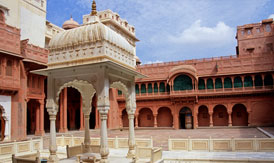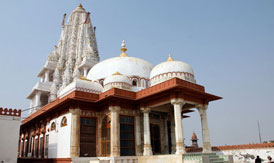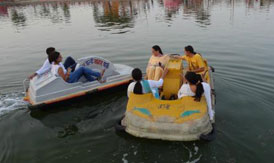Bikaner
Junagarh Fort
 This fort was built by Raja Rai Singhji, the sixth ruler of Bikaner, who ruled form 1571 to 1612 AD. Raja Rai Singhji could Marshal the revenues of a Kingdom increased by the conquest of half Marwar and grant of half Gujrat and made use of ample funds from Jodhpur and Western Deccan for the construction of this fort. A contemporary of Mughal Emperor Akbar and Emperor Jehangir, he held a very high rank in Junagarh Fort, Bikaner the Imperial court. As a reward for this services as military commander, he was granted fields of Gujrat and Burhanpur by the Emperor. During his tenure in imperial service he traveled far and wide which gave him vision and great ideas about art and architecture and we can see how meticulously these ideas were incorporated in the architectural styles of his building in Junagarh fort.
This fort was built by Raja Rai Singhji, the sixth ruler of Bikaner, who ruled form 1571 to 1612 AD. Raja Rai Singhji could Marshal the revenues of a Kingdom increased by the conquest of half Marwar and grant of half Gujrat and made use of ample funds from Jodhpur and Western Deccan for the construction of this fort. A contemporary of Mughal Emperor Akbar and Emperor Jehangir, he held a very high rank in Junagarh Fort, Bikaner the Imperial court. As a reward for this services as military commander, he was granted fields of Gujrat and Burhanpur by the Emperor. During his tenure in imperial service he traveled far and wide which gave him vision and great ideas about art and architecture and we can see how meticulously these ideas were incorporated in the architectural styles of his building in Junagarh fort.
Jain Temple Bhandasar
 This temple is oldest existing structure in Bikaner. The beautiful temple was erected near Laxminath temple in 1514A.D. by two brothers Bhandeshwar and Sandheswar and named after them. This marvel piece of architecture is dedicated to 23rd teerthankar "PARSVANATH JI".The seth was very particular about every penny in his personal life but when it came to religious point he ordered hundreds of maunds of Ghee (Clarified Butter) and coconuts to be freely used in the foundation. This temple is Carved in red sand stone and white marble - its famous for carvings ,wall paintings , structural beauty and artisticly designed statues. The rich mirror work, decor and frescoes of Bhandashah: and their gold leaf paintings are noteworthy. The old city of Bikaner, Rajasthan is a cluster of maze like roads housing some of the city’s finest attractions. It is here where tourists will find an unusually ornate two-storied Jain temple. Known as Bhandreshwar (Bhandasar) Temple, it’s name is taken from the wealthy merchant, Bhandasa Oswal, who commissioned the construction in 1468.
This temple is oldest existing structure in Bikaner. The beautiful temple was erected near Laxminath temple in 1514A.D. by two brothers Bhandeshwar and Sandheswar and named after them. This marvel piece of architecture is dedicated to 23rd teerthankar "PARSVANATH JI".The seth was very particular about every penny in his personal life but when it came to religious point he ordered hundreds of maunds of Ghee (Clarified Butter) and coconuts to be freely used in the foundation. This temple is Carved in red sand stone and white marble - its famous for carvings ,wall paintings , structural beauty and artisticly designed statues. The rich mirror work, decor and frescoes of Bhandashah: and their gold leaf paintings are noteworthy. The old city of Bikaner, Rajasthan is a cluster of maze like roads housing some of the city’s finest attractions. It is here where tourists will find an unusually ornate two-storied Jain temple. Known as Bhandreshwar (Bhandasar) Temple, it’s name is taken from the wealthy merchant, Bhandasa Oswal, who commissioned the construction in 1468.
Lalgarh Palace and Museum
 Lalgarh Palace is one of the chief testaments of the city that was built by Maharaja Ganga Singh in 1902. He built this palace in the memory of his father Maharaja Lal Singh Ji. The palace is an architectural marvel and is beautifully constructed using red sandstone. This architectural testament was designed by Sir Swinton Jacob and is famous for it’s craftsmanship. Chief attractions of the historic monument are the latticework and filigree work in sandstone. The architectural works are the combination of Rajput, Mughal and European style of architecture. Overhanging balconies and delicate latticework of the palace draw the attention of tourists. Apart from this, the gardens with dancing peacocks and bougainvillea are the other attractions at theattract visitors to the Lalgarh Palace. The fort is situated at a distance of 3 kmilometres from the city centre and can be reached conveniently. with the availability of public transportation.
Lalgarh Palace is one of the chief testaments of the city that was built by Maharaja Ganga Singh in 1902. He built this palace in the memory of his father Maharaja Lal Singh Ji. The palace is an architectural marvel and is beautifully constructed using red sandstone. This architectural testament was designed by Sir Swinton Jacob and is famous for it’s craftsmanship. Chief attractions of the historic monument are the latticework and filigree work in sandstone. The architectural works are the combination of Rajput, Mughal and European style of architecture. Overhanging balconies and delicate latticework of the palace draw the attention of tourists. Apart from this, the gardens with dancing peacocks and bougainvillea are the other attractions at theattract visitors to the Lalgarh Palace. The fort is situated at a distance of 3 kmilometres from the city centre and can be reached conveniently. with the availability of public transportation.
The Royal Cenotaphs
 Most of the old ones are made of Dulmera red sandstone where as in the later ones marble has also been used widely. The stone carvings in both the styles are noticeable. Commonly the site is known as Ganga Singh ki Chatriyan. As you enter the premises you are attracted by the high rising structures. A notice boards mounted on the wall outside by the Assistant Director – Rajasthan Tourism provided a basic information about the Royal Cenotaphs. The latest Cenotaph mentioned on the boards is of Maharaja Karni Singh (1950-88A.D.) but it is not true. There are two small sized cenotaphs to the right belonging to Maharaj Sadul Singh (11 December 1925 – 16 June 2007) and Maharaj Rajesh Kumar Singh (23 May 1959 – 14 May 2010). You are not allowed to go in with your shoes on so leave them at the entrance gate. The caretaker, after providing you an entry ticket (Rs. 5/-) which is too less an amount for such an beautiful site, keeps your footwear in his room and gives you flip-flops, made of this sole and upper made of cloth.
Most of the old ones are made of Dulmera red sandstone where as in the later ones marble has also been used widely. The stone carvings in both the styles are noticeable. Commonly the site is known as Ganga Singh ki Chatriyan. As you enter the premises you are attracted by the high rising structures. A notice boards mounted on the wall outside by the Assistant Director – Rajasthan Tourism provided a basic information about the Royal Cenotaphs. The latest Cenotaph mentioned on the boards is of Maharaja Karni Singh (1950-88A.D.) but it is not true. There are two small sized cenotaphs to the right belonging to Maharaj Sadul Singh (11 December 1925 – 16 June 2007) and Maharaj Rajesh Kumar Singh (23 May 1959 – 14 May 2010). You are not allowed to go in with your shoes on so leave them at the entrance gate. The caretaker, after providing you an entry ticket (Rs. 5/-) which is too less an amount for such an beautiful site, keeps your footwear in his room and gives you flip-flops, made of this sole and upper made of cloth.
Gajner Temple
 Spread over 6000 acres, the forest of Gajner was transformed into a famous shooting reserve for sand grouse when Maharaja Ganga Singh of Bikaner built the palace next to the Gajner Lake. Sir Ganga Singh was also an avid wildlife conservator. He introduced different breeds of deer and birds into the state sanctuaries, had wildlife preserves replanted, and ensured that wardens were posted to prevent poaching. There was a ban on hunting of animals during the breeding season and the killing of female animals and their young was strictly prohibited. Maharaja Karni Singh, grandson of Sir Ganga Singh, converted the hunting preserve of Gajner in to a wildlife sanctuary, a haven to endangered antelopes like the chinkara, black buck, blue bull as well as other rare animals. The sanctuary and lake attract more than a hundred species of migratory birds during the winter. Today you can shoot to your heart’s content, but with a camera.
Spread over 6000 acres, the forest of Gajner was transformed into a famous shooting reserve for sand grouse when Maharaja Ganga Singh of Bikaner built the palace next to the Gajner Lake. Sir Ganga Singh was also an avid wildlife conservator. He introduced different breeds of deer and birds into the state sanctuaries, had wildlife preserves replanted, and ensured that wardens were posted to prevent poaching. There was a ban on hunting of animals during the breeding season and the killing of female animals and their young was strictly prohibited. Maharaja Karni Singh, grandson of Sir Ganga Singh, converted the hunting preserve of Gajner in to a wildlife sanctuary, a haven to endangered antelopes like the chinkara, black buck, blue bull as well as other rare animals. The sanctuary and lake attract more than a hundred species of migratory birds during the winter. Today you can shoot to your heart’s content, but with a camera.
Skybird Water Park
 Skybird Water Park, situated at a distance of around 8 km from Bikaner, is the largest water and amusement park in Western Rajasthan. It was established in 1999 as a part of Ess Ell Entertainments. It is a popular recreational spot for locals as well as tourists and a great place for the family fun and small picnics. A popular tourist spot for family and friends to have fun and enjoyment, the Skybird Water Park gives you an ultimate experience of water sports and rides. You can get a lot of adventure and feel like an oasis in the desert. Sky Bird Water Park Nal is situated 8 k.m. from Bikaner city towards west in a village called Nal on Bikaner-Jaisalmer Highway. It is one of the ultimate destination for youth and families for enjoying fun and small picnics. It is one of the largest water and amusement park in western Rajasthan.
Skybird Water Park, situated at a distance of around 8 km from Bikaner, is the largest water and amusement park in Western Rajasthan. It was established in 1999 as a part of Ess Ell Entertainments. It is a popular recreational spot for locals as well as tourists and a great place for the family fun and small picnics. A popular tourist spot for family and friends to have fun and enjoyment, the Skybird Water Park gives you an ultimate experience of water sports and rides. You can get a lot of adventure and feel like an oasis in the desert. Sky Bird Water Park Nal is situated 8 k.m. from Bikaner city towards west in a village called Nal on Bikaner-Jaisalmer Highway. It is one of the ultimate destination for youth and families for enjoying fun and small picnics. It is one of the largest water and amusement park in western Rajasthan.
Dunes Safari & Camp Rajputana
 Since, Bikaner is within close proximity to the great Thar Desert, taking a safari is the obvious things to do. There are jeeps and camels available for the sand dune safari. One can choose the duration of the safari, even the option to camp amidst desert and witness folk dance and music is also made available here. Depending upon the duration of the safari, one can see several destinations like Raisar, Khichan, Balakaya Dhora and Phlodi. Let us introduce you to our special royal Marwari horses, an ancient breed of warhorses whose history is entwined with the history of Rajasthan and the Rajputs. It is rightly said that “one cannot separate a Rajput from his horse” and there is a saying: “If God did not create the horse, he would not have created the Rajput.” An age-old way of travelling and time pass for the Maharajas, the kings, princes and nobles, it was practiced in India for centuries and is now revived for visitors and horse-lovers.
Since, Bikaner is within close proximity to the great Thar Desert, taking a safari is the obvious things to do. There are jeeps and camels available for the sand dune safari. One can choose the duration of the safari, even the option to camp amidst desert and witness folk dance and music is also made available here. Depending upon the duration of the safari, one can see several destinations like Raisar, Khichan, Balakaya Dhora and Phlodi. Let us introduce you to our special royal Marwari horses, an ancient breed of warhorses whose history is entwined with the history of Rajasthan and the Rajputs. It is rightly said that “one cannot separate a Rajput from his horse” and there is a saying: “If God did not create the horse, he would not have created the Rajput.” An age-old way of travelling and time pass for the Maharajas, the kings, princes and nobles, it was practiced in India for centuries and is now revived for visitors and horse-lovers.